Kingston HyperX 3K (240GB) SSD Review
by Anand Lal Shimpi on April 10, 2012 3:00 AM ESTWith OCZ intent on moving as much volume to its in-house Indilinx controllers as possible, SandForce (now LSI) needed to expand to additional partners. OCZ has strong control over the channel so SandForce needed to turn to multiple partners to diversify its portfolio. One key win for SandForce was Kingston. We saw the launch of the first Kingston SandForce (SF-2281) based drive last year under the HyperX brand. Today Kingston is announcing a lower cost version of the drive with the HyperX 3K.

Kingston's HyperX 3K (top) vs. Kingston's HyperX (bottom)
The 3K in this case refers to the number of program/erase cycles the NAND inside the SSD is rated for. As we've discussed on numerous occasions, NAND endurance is a finite thing. The process of programming a NAND cell is physically destructive to the cell itself and over time you'll end up with NAND that can no longer hold a charge (or your data).
Intel's 50nm MLC NAND was rated for 10,000 program/erase cycles. Smaller transistor geometries, although tempting from a cost/capacity standpoint, do come with a reduction in program endurance. At 34nm Intel saw its p/e count drop to 5,000 cycles, and at 25nm we saw a range from 3,000 - 5,000. Modern day SSD controllers include wear leveling logic to ensure that all cells are written to evenly, so even at the lower end of the Intel 25nm range there's more than enough lifespan for a typical client workload. Let's do some math on a hypothetical 100GB drive with four different types of NAND (3K, 5K, 10K and 30K P/E cycles):
| SSD Endurance | ||||||
| 3K P/E Cycles | 5K P/E Cycles | 10K P/E Cycles | 30K P/E Cycles | |||
| NAND Capacity | 100GB | 100GB | 100GB | 100GB | ||
| Writes per day | 10GB | 10GB | 10GB | 10GB | ||
| Write Amplification | 10x | 10x | 10x | 10x | ||
| P/E Cycles per Day | 1 | 1 | 1 | 1 | ||
| Total Estimated Lifespan | 8.219 years | 13.698 years | 27.397 years | 82.191 years | ||
Assuming you write 10GB to your drive every day (on the high end for most client workloads), and your workload is such that the controller sees an effective write amplification of 10x (due to wear leveling/garbage collection the controller has to write 10x the amount of data to NAND that you write to host), you'll blow through one p/e cycle per day. For 25nm 3K p/e cycle NAND that works out to be 8.219 years, at which point your data will remain intact (but presumably read-only) for 12 months. Heavier workloads come with higher write amplification factors, but for client use this math works out quite well.
NAND is binned similar to CPUs, except instead of binning for clock speed and power NAND is binned for endurance. Intel offers both 3K and 5K rated 25nm NAND (among others, including ~30K p/e cycle eMLC NAND). The standard HyperX drive ships with 5K 25nm Intel MLC NAND, while the HyperX 3K ships with 3K 25nm Intel MLC NAND.
There's no obvious difference in Intel's part numbers, so I'm not sure if there's a good way to tell whether you're looking at 3K or 5K rated parts from Intel.
The loss of endurance shouldn't matter for most client workloads as I mentioned above, but if you're deploying these drives in a write heavy enterprise environment I'd look elsewhere. Otherwise, the cost savings are worth it:
| SSD Pricing Comparison | ||||||
| 90GB | 120GB/128GB | 240GB/256GB | 480GB/512GB | |||
| Crucial m4 | $154.99 | $299.99 | $549.99 | |||
| Intel SSD 520 | $184.99 | $344.99 | $799.99 | |||
| Kingston HyperX | $189.99 | $329.99 | $874.99 | |||
| Kingston HyperX 3K | $139.99 | $169.99 | $319.99 | $699.99 | ||
| Samsung SSD 830 | $174.99 | $299.99 | $779.99 | |||
| OCZ Octane | $199.99 | $339.99 | $849.99 | |||
| OCZ Vertex 3 | $199.99 | $339.99 | $1199.99 | |||
| OCZ Vertex 4 | $179.99 | $349.99 | $699.99 | |||
HyperX 3K drives are already available via Newegg. The biggest cost savings appear to be at the 480GB capacity, although you'll save a good $10 - $20 for most capacities.
Kingston also offers an optional upgrade bundle kit including a handy screwdriver, SATA cable, USB cable, Acronis cloning software, SATA to USB adapter and a 3.5" sled for mounting in a desktop case. It's a nice bundle although I really wish we'd see better 3.5" adapters in these kits. The bundle will set you back another $10 over the prices in the table above.
Like many SandForce partners, Kingston offers a toolbox to view SMART data however you cannot secure erase the drive from the utility. A separate utility is offered to handle firmware updates.
Performance & Final Words
With Kingston's latest performance is, thankfully, unharmed. The HyperX 3K performs just as well as the 5K rated HyperX drive:
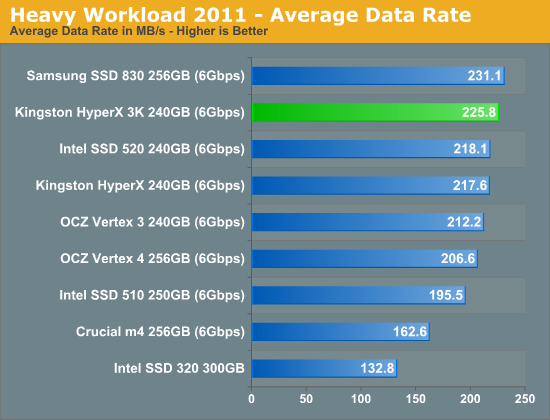
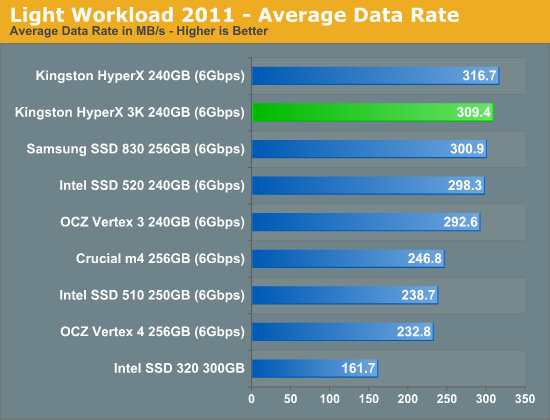
Kingston's SF-2281 implementation has always been extremely fast and the HyperX 3K is no exception. You are looking at one of the fastest drives we've ever tested. I've included our usual benchmarks in the subsequent pages but you can also use Bench to compare drives directly.
The risk, as always, with SandForce based drives is that you'll run into a combination of drive + system that triggers either an incompatibility or the infamous BSOD issue. I haven't seen the bug crop up on the HyperX 3K but I haven't spent a lot of time looking for it either.
All I can offer is the same caution we tack onto most of our SSD reviews. If you know someone with a system similar (identical?) to yours who isn't running into problems then you'll probably be fine.
If you've had a good experience with the HyperX in a system, then the HyperX 3K is a no-brainer. You get similar, already great, performance at a lower cost.


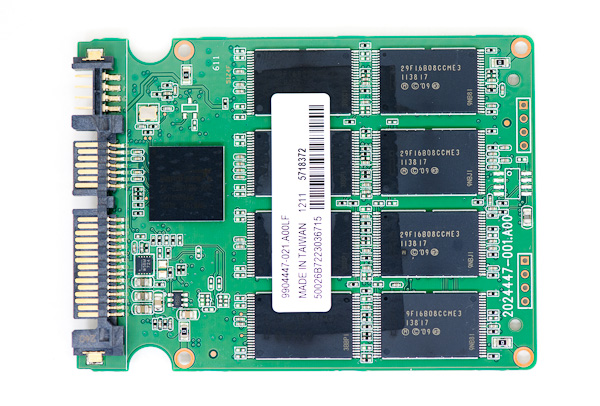
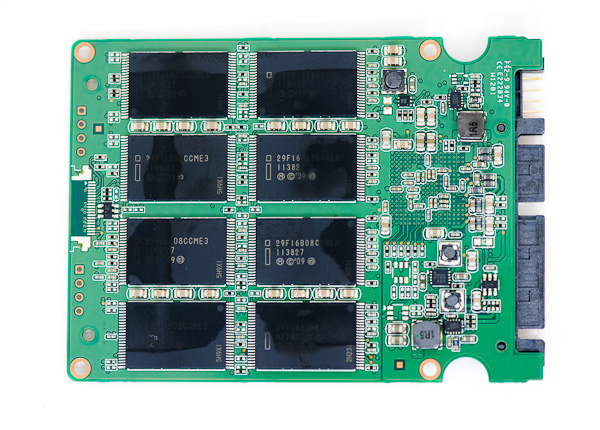

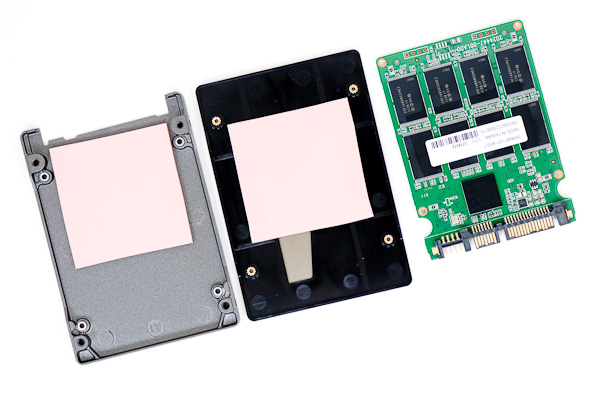








44 Comments
View All Comments
NetCommercial - Thursday, November 22, 2012 - link
Long time reader just signed up to comment as it appears you actually read them and do take into consideration the comment itself.First off thank you for the benchmarks and simplifying the results the best you can. I enjoyed the article showing the Kingston X that is on sale at Newegg for BFriday and was considering it.
After reading I will pass. I am a video editor. I think a good percentage of us are in some way using our computers for more then gaming. After all the rigs people are putting together are ridiculous for gaming. I play games online and get kicked all the time for being too 'fast'. That is with a dinosaur of a pre-made Dell bucket.
With that being stated I would like to see an area where you guys do shoot outs with the same sized/priced equipment doing renders with decent sized files. For instance the review did on the King x was terrific however where was Plextor @ ? It is in the price range and does compete with the Sammy 830/ 840pro IMO... This article just started to brief on that scenario.
Again Thank you for your help, advice and time you put into these articles. You are one of my resource hubs of trusted information.
Best,
NetCommercial
ickibar1234 - Monday, December 2, 2013 - link
The Desktop IOMeter 4K random read of only 40MB/s is kind of sad. I'm sure that is with a queue depth of 1 but still.Dahaka - Monday, December 14, 2015 - link
Hi!.Almost 4 years since this review and is an awesome article, that's why i come here to post some doubts about this SSD.
Anyone can tell me (approximately) how good or bad will perform this SSD into a workload enviroment?, like using an ERP (like Microsoft Dynamics plus Roadnet)?.
The OS and programs will be virtualized.
If anyone needs more specifications about the server i can give more details.
Regards.
remax - Sunday, June 19, 2016 - link
Hyper X is the way to go! But why listen to me - look at my SSD data - speaks for itself:KINGSTON SH103S3240G
240GB
SMART READ DATA
Revision: 10
Attributes List
1: (SSD Raw Read Error Rate) Normalized Rate: 120 Sectors Read: 0 Read Errors: 0
5: (SSD Retired Block Count) Spare blocks remaining 100% Retired Block 0
9: (SSD Power-On Hours) Value 84 Total 14084 hrs 47 mins
12: (SSD Power Cycle Count) Power Cycle Life Remaining 99% Number of power cycles 1334
171: (SSD Program Fail Count) Program Error Count 0
172: (SSD Erase Fail Count) Erase Error Count 0
174: (SSD Unexpected power loss count) Unexpected power loss Count 259
177: (Wear Range Delta) Wear Range Delta 2%
181: (Program Fail Count) Program Error Count 0
182: (Erase Fail Count) Erase Error Count 0
187: (SSD Reported Uncorrectable Errors) Normalized Value 100 lifetime URAISE Errors 0
194: (SSD Temperature Monitoring) Normalized temp 36 Current 36 High 81 Low 236
195: (SSD ECC On-the-fly Count) Normalized Value 120 Sectors Read 0 UECC Count 0
196: (SSD Reallocation Event Count) Normalized Value 100 Reallocation Event Count 0
201: (SSD Uncorrectable Soft Read Error Rate)Normalized Value 120 Sectors Read 0 Uncorrectable Soft Error Count 0
204: (SSD Soft ECC Correction Rate (RAISE) Normalized Value 120 Sectors Read 0 Soft ECC Correction Count 0
230: (SSD Life Curve Status) Normalized Value 100
231: (SSD Life Left) Life Remaining 100%
233: (SSD Internal Reserved) 13615
234: (SSD Internal Reserved) 15250
241: (SSD Lifetime writes from host) lifetime writes 15250 GB
242: (SSD Lifetime reads from host) lifetime reads 9061 GB
Any questions?